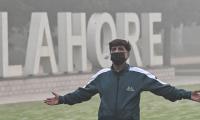Singapore: Venue was Shangri-La Hotel in Singapore. All roads leading to the grand setting were blocked for strictest security. Checks were so many that the guests at the hotel were informed through a special letter to expect inconvenience. Lanes surrounding the hotel were patrolled by beefed up contingents of the Singapore Police Force. Inside the packed hall the audience was a powerful mix of defense and diplomatic officials from some of the most powerful nations on earth. Why? Because Indian Prime Minister Narendra Modi came to deliver his keynote address at the International Institute of Strategic Studies’ (IISS) 17th Shangri-La Dialogue.
Apart from the 10 defense ministers of the leading Western countries including the US Defense Secretary General (R) James Mattis, the 600-strong audience of soldiers, defense contractors, risk analysts, diplomats, policy advisors, think tank gurus, academics and carefully chosen global delegates, waited to hear what’s on offer from the Indian premier with some hoping he would recreate the teleprompter magic produced at the Capitol Hill making the US lawmakers sit, stand and clap after every few sentences. That was not to be, possibly because IISS crowd is hardly known for choreographed performances. The 37 minutes of bureaucratic officialese was a limp attempt to present Narendra Modi as something that he is not - a philosopher of sorts, a historian of note, an entrepreneur of repute or a genuinely admired diplomat.
So what exactly was expected of him at the 60th anniversary event of one of the most reputed international think tanks? That he would lay bare his plan or policy wherein India would possibly agree to police the Asia-Pacific sea lanes to ensure that the international maritime trade is not impacted by the Chinese regional or aspirations. In return, the Western commentators and policy experts are already ready to delete Asia from the moniker and rebrand it as Indo-Pacific.
But the wily fox of Indian politics that Modi has so far turned out to be, he surfed at length with snippets of India’s relations with ASEAN, accounts of his recent trips to Indonesia, Malaysia and Singapore after visiting China, Russia and France. Trouble with reading from the teleprompter and that too an alien text prepared by baboos is that one can’t afford to shift gaze to look at the audience to realize how many of them are yawning or have started surfing on mobile phones. A lapse of a second can seriously dent one’s image in the modern world of social media. So very efficiently he went on reading the bureaucratic gospel that threw a policy statement here and there like “
One credit, no doubt, goes to his speechwriters – of filling the plate with so many ideas that the takers were left aghast as to what exactly Modi was offering. From the promise in Washington to expectation from Wuhan and from Belt & Road Initiative (BRI) to praising Gujaratis for being one of the earliest maritime merchants, he took the audience on a whirlwind of kaleidoscopic imagination of a collective peaceful, prosperous tomorrow. A few example of maritime cooperation combating piracy on the high seas and robbery against ships in Asia were thrown in for good effect.
Despite historical anecdotes of presumed millennia-old relation with the East Asian nations, Modi made it clear that India is not ready to play Varuna or Posiedon anytime soon despite the enhanced interest in the construct of an Indo-Pacific naval region after President Trump’s visit to the Far East last November. For Modi “
And when Modi was done delivering his magnum opus on the possibilities of Indo-Pacific maritime cooperation and challenges, conversations on dinner tables reverted to what Prime Minister Modi, his government and party, the Bharatiya Janata Party, are actually doing to India and Indian society. Diplomats and delegates discussed the recent protest marches by Christian congregation leaders in south India, beef-eating ban on Muslims and the killings carried out in this regard by purportedly the BJP activists or supporters, the on-going human rights violations during the security forces’ action in the Indian-held Kashmir.
One diplomat quoted a Foreign Policy article by Manjari Chatterjee Miller, a Boston-based academic of Indian origin and then forwarded the link to those sharing her table. Ms Miller opens her piece by saying that Modi has divided India along ideological and religious lines. There are other potent voices within India constantly writing that democracy is in serious danger in the proverbial “largest” democracy in the world ever since Narendra Modi took over the government in India.
May be Modi knew better than the others the malaise that South Asian societies suffer from – use of religious bigotry when political promises are hard to deliver. Or may be he was the only one in BJP to exploit the fault lines more imaginatively than his political forebears – men like A B Vajpayee and L K Advani.
India is heading for an election in 2019 and Modi is trying to project himself as an astute politician within the country and an affable statesman/diplomat abroad especially at a time when his party had a few minor bumps in recent elections, said one American India-watcher. “He, however, remains the most potent politician that Indian politics has thrown up in a while.”
Only the vote next year would test the statement.
During hearing, 41 accused, including provincial Minister Meena Khan and MNA Asif Khan, appeared before court
Peshawar City Senior Vice President Malik Aslam and General Secretary Taqdeer Ali resigned from their posts
As token of appreciation, KP Culture and Tourism Authority presented them with traditional shawls
Building fires are common in India due to lack of firefighting equipment and routine disregard for safety regulations
He was speaking at United Nations Climate Change Conference in Baku, Azerbaijan
Buried in debt, developing countries do not want the money to come in the form of loans







